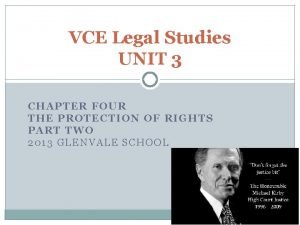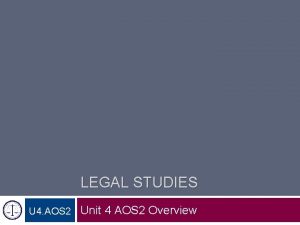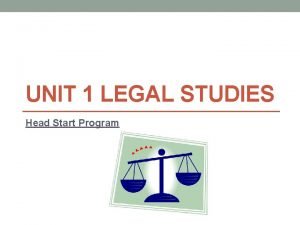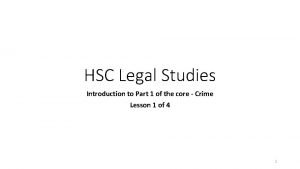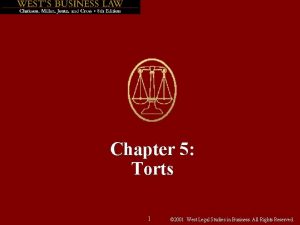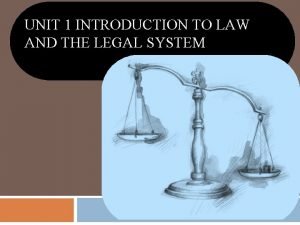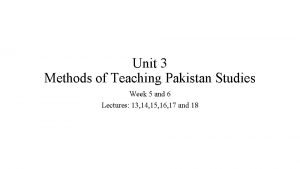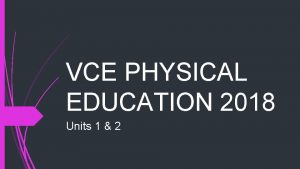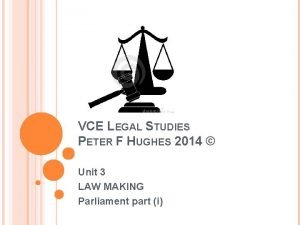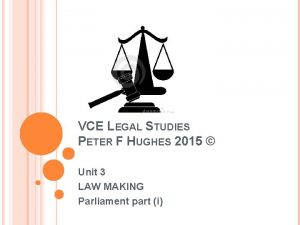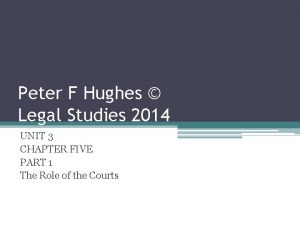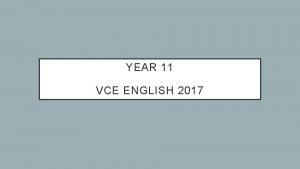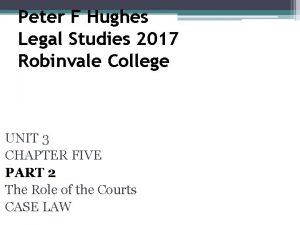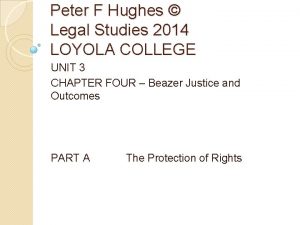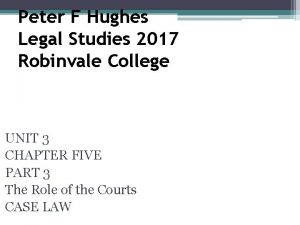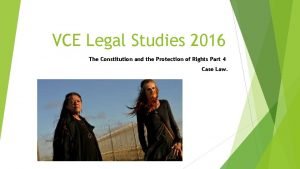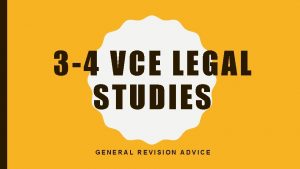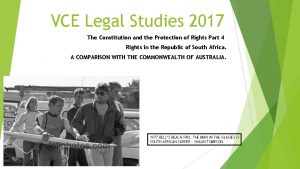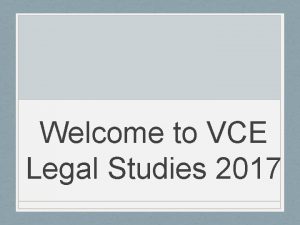VCE Legal Studies Peter F Hughes 2013 Unit























- Slides: 23

VCE Legal Studies Peter F Hughes 2013 © Unit 3 LAW MAKING Parliament part (ii)

Victorian State Parliament P 18 • Fixed 4 year terms • Legislative Assembly – House of Govt - Makes laws • Legislative Council – Like the senate - House of review - ensures responsible govt

Structure of the Vic. Parliament (Bicameral system) Queen Legislative Council Legislative Assembly • Represented by: • Governor • Upper House • Lower House

How our Constitutional Monarchy works. • Queens representative is the Governor General (GG) • GG appoints a Federal Executive Council comprising Prime Minister (PM) and senior Government Ministers • Executive Council advises GG on matters relating to the Government of the Commonwealth. It is essential that you grasp this concept.

How our Constitutional Monarchy works. Executive power is in the hands of the govt. • GG acts on the advice of the Executive Council • GG ensures that the democratic system we have remains sound. • GG as a figure head gives Royal Assent to legislation after it has passed both houses. • GG has reserve powers to dissolve parliament or appoint a PM under certain conditions. p 21

How our Constitutional Monarchy works. Governor General and Reserve Powers • Outside those given under the Constitution • Have historic influences • Last exercised in 1975 when the GG made a decision to dismiss a government. • Constitutional experts had varying opinions about the exercise of the reserve powers. P 22 (ensure you note what these powers are)

Parliamentary Functions • A law making body • The Commonwealth Parliament includes the Crown’s Rep (GG), Senate and House of Reps members. • Note – Parliament is not just the government and its ministers.

Parliamentary Functions • Good Government is achieved by making laws on behalf of the people. • Good Government ensures those laws reflect society’s views and values. • Provide a place where debate and representation are made eg question time. • Delegation of law making power. • Budgetary measures

Parliamentary Functions Committees: p 23 2012 a public notice in the Ballarat Courier regarding the senate committee on the wind farm matters. Committees – Investigate the needs of the people and report back to govt.

Parliamentary Functions Cabinet • The government’s Prime Minister (PM) and Senior Ministers. • Cabinet formulates govt. policy and introduces proposed laws in the form of Bills of parliament (Parliamentary Bills) • Cabinet members must maintain the support of their party members or they resign.

The Principals of the Australian Parliamentary System 3 main principals of the Australian Parliamentary System (always an exam question favourite) (i) Representative Govt (ii) Responsible Govt (iii) Separation of Powers

Representative Govt • The Govt. represents the views of the majority of the people • A democratic principal • Constitution s 7 and s 24 Members of the House of Reps and the senate must be chosen by the people. The Bicameral system ensures this representation. * Be able to discuss this concept with examples.

Responsible Govt. • The Govt has been elected by the people and has a responsibility to them. • Answerable • Accountable • Senate examining bills from the House of Reps before they are turned into legislation. • Question time in parliament • Ability for public to be involved in the law making process. • Govt must have a majority in lower house

Separation of Powers This is one concept that students often have difficulty in grasping. The Principal of Separation of Powers is at the foundation of our entire parliamentary system – let me know if you are having trouble with it. § The separation relates to 3 different types of power in our parliamentary system § Separate power ensures no one body has absolute power in the legal system

Separation of Powers Provided by the Constitution that separate powers are functioning at a Federal Level. Executive Power – Governor General’s administration of the government. Legislative Power – Parliament making laws. Judicial Powers – Power of the Tribunals and Courts to interpret law, enforce the law and resolve disputes.

Separation of Powers EXECUTIVE POWER JUDICIAL POWER LEGISLATIVE POWER Executive Power and Legislative Power are Joined in Aust. Cabinet holds this power as expressed in the idea of responsible government.

Separation of Powers JUDICIAL POWER The High Court of Australia and other Federal Courts have the power under the Constitution to decide how the legislation created by parliament is interpreted. The judges are appointed by the Governor General. Judicial Power is therefore separate and independent from legislative and Executive Power.

Separation of Powers Legislative Power Judicial Power Parliament Makes a Law Court interprets the Law Subordinate Authority Creates a Law Tribunal settles a dispute

Reasons for the Separation of Powers p 28 • Allows for checks and balances in our system • Government stability is ensured • Independence between Parliamentary bodies and the Courts • Holds power in Parliament to account. Example: The Malaysia solution for asylum seekers coming to Australia by boat. Labor government forced to change proposed legislation as it was deemed unconstitutional in the High Court of Aust. .

Effectiveness of the Parliamentary Legal System P 30 • Ensure that you form an opinion on this issue and are able to argue both sides of the topic. • Members of Parliament are expected to vote ‘along party lines’. • Governments with majorities in both houses can pass any legislation they like.

Effectiveness of the Parliamentary Legal System • Public debate is allowed to gauge the opinion ‘of the people. ’ • Parliament’s ability to change and make law is restricted by the constitution. • Parliament may also be restricted by public opinion on controversial matters.

Effectiveness of the Parliamentary Legal System • Laws must reflect the values of our community. Example – the wind farms - The tax on carbon polluters • Democratic principal of voter participation in elections.

2014 exam question Q 3 (3 marks) Explain the principle ‘separation of powers’.
 Legal studies study design
Legal studies study design Legal studies unit 4 aos 2
Legal studies unit 4 aos 2 Legal studies unit 1
Legal studies unit 1 Outdoor and environmental studies study design
Outdoor and environmental studies study design Vce theatre studies
Vce theatre studies Meriel hughes
Meriel hughes Vce literature unit 1 and 2
Vce literature unit 1 and 2 Vce physics unit 1 and 2
Vce physics unit 1 and 2 Legal studies sfu
Legal studies sfu Factors affecting criminal behaviour legal studies
Factors affecting criminal behaviour legal studies West legal studies
West legal studies Paradigm shift from women studies to gender studies
Paradigm shift from women studies to gender studies Unit 10, unit 10 review tests, unit 10 general test
Unit 10, unit 10 review tests, unit 10 general test Unit 1 introduction to law and the legal system
Unit 1 introduction to law and the legal system Textbook method for teaching of pakistan studies
Textbook method for teaching of pakistan studies Statistical investigations unit 3 section a
Statistical investigations unit 3 section a Business studies unit 1
Business studies unit 1 Social studies unit 2 test answers
Social studies unit 2 test answers Gcse business studies unit 1
Gcse business studies unit 1 Vce argument analysis
Vce argument analysis How is study score calculated
How is study score calculated Edrolo
Edrolo Vce physical education units 1 and 2 notes
Vce physical education units 1 and 2 notes Vce music performance
Vce music performance
